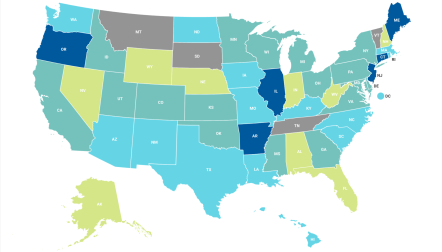
Blog post
6 things to know about GLP1-RAs and CKD

In January 2025, the Food and Drug Administration (FDA) approved an injectable form of semaglutide (Ozempic), a GLP1-RA, to treat chronic kidney disease (CKD) in people with type 2 diabetes.
GLP1-RAs were initially designated as a medicine to help manage blood sugar levels for people with type 2 diabetes. Further studies have shown that GLP1-RAs might be beneficial for people with type 2 diabetes and other conditions, like CKD and obesity. Approval of this medicine is significant for those with CKD and type 2 diabetes, as it offers additional support to manage both conditions.
Here are 6 important things you need to know about GLP1-RAs, CKD and the FDA approval:
1. What is a GLP1-RA and how does it work?
GLP1-RAs are a class of medicine that help manage blood sugar levels. They can come as injections or in tablets taken by mouth. In January 2025, an injectable form of a GLP1-RA, semaglutide (Ozempic), was approved to reduce the risk of chronic kidney disease (CKD) worsening in people who also have type 2 diabetes.
GLP1-RAs act as glucagon-like peptide 1, a hormone that is released when you eat. When your blood sugar gets high, the medicine will send a signal to your pancreas to release more insulin, which helps sugar from your blood move into your cells. GLP1-RAs also blocks glucagon, another hormone that raises your blood sugar levels. As a result, your digestion will slow down, keeping your blood sugar steady and you will feel full for longer.
2. Can any CKD patient take this medicine?
No, the injectable form of semaglutide (Ozempic) has been approved only for people who have type 2 diabetes who also have CKD. This means you must have type 2 diabetes to be eligible. This is because people with type 2 diabetes are at a higher risk for kidney disease. Using Ozempic can lower the risk of kidney failure and slow the rate of kidney damage.
People who have early-stage CKD (1-3), are at an increased risk for cardiovascular disease and people who struggle to control their blood sugar levels are likely to benefit the most from a GLP1-RA.
If you have both type 2 diabetes and CKD, talk to your doctor about GLP1-RAs. They will review your medical history to see if this medicine may be right for you.
3. Will this replace other medicines that I might be taking?
GLP1-RAs are not meant to replace other medicines. Instead, they are used to complement other medicines and are typically added to existing treatment plans to better manage blood sugar and reduce risk of CKD worsening. Some common medicines to treat diabetes and CKD include:
- Metformin or finerenone, which help lower your blood sugar
- SGLT2 inhibitors, medicines that help lower your blood sugar and prevent kidney and heart disease from getting worse
- ACE inhibitors and ARBs, which lower your blood pressure
If you have CKD and type 2 diabetes, you might be taking many different medicines. Keep track of the medicines you take, including how often and how much you take, so you can discuss any potential changes with your doctor.
4. What are the benefits of GLP1-RAs?
For people with type 2 diabetes and CKD, GLP1-RAs can be beneficial for many reasons.
GLP1-RAs can reduce the risk of your kidney disease getting worse over time and reduce your risk of kidney failure. These medicines help to control your blood sugar levels. This means that less sugar enters your kidneys, preventing damage to the filters of your kidneys.
GLP1-RAs can also help with weight loss. For people with obesity and CKD, this can alleviate some of the stress put on your kidneys.
In addition to helping your kidneys, GLP1-RAs offer cardiovascular benefits by helping to lower your blood pressure and bad cholesterol (LDL) which can lower your risk of dying from heart disease.
GLP1-RAs can also improve your quality of life, so slowing kidney damage and managing diabetes can help improve your overall wellbeing.
5. What are the risks of taking GLP1-RAs?
Like many medicines, there is a lengthy list of side effects for GLP1-RAs. Some common side effects include:
- Nausea
- Vomiting
- Diarrhea
- Stomach pain
- Constipation
More serious side effects may include:
- Low blood sugar levels
- Dehydration, which can cause kidney problems
- Gallbladder problems
Long-term use of GLP1-RAs can also increase the risk of other issues, including pancreatitis (inflammation of your pancreas) and diabetic retinopathy (changes to your vision).
If you notice these or any other side effects, be sure to tell your doctor.
6. Will taking a GLP1-RA affect my ability to get a kidney transplant?
Weight loss is a common experience for people taking GLP1-RAs. For some people, this can help them reach a healthier weight.
It is common for body-mass index (BMI) to be criteria for transplant, and this takes into account your weight. If you previously could not get a transplant because your BMI was too high, losing weight with the help of a GLP1-RA may help you qualify for a transplant. Talk to your care team and transplant coordinator for information specific to your transplant center.
The FDA approval of a GLP1-RA to treat CKD in people with type 2 diabetes is exciting because this medicine can help people manage their blood sugar and reduce the risk of kidney failure. If you think this medicine is something that can help you, talk to your doctor about adding a GLP1-RA into your treatment plan.




